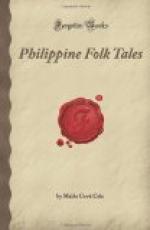[153] A common fancy in Malay legends is the supernatural origin of a child in some vegetable, usually a bamboo. See note 2, p. 99.
[154] A bird something like a hawk.
[155] See note 1, p. 134.
[156] This is undoubtedly a worked-over story, probably brought in from Europe. Kings, queens, palaces, etc., were, of course, unknown to the people before the advent of the Spaniards.
[157] A long knife.
[158] The fermented juice of the cocoanut.
[159] This tale bears a striking resemblance to Grimm’s “The Table, the Ass, and the Stick,” Fairy Tales.
[160] These Visayan tales reflect old beliefs covered with a veneer of European ideas. The Visayan still holds to many of the old superstitions, not because he has reasoned them out for himself, but because his ancestors believed them and transmitted them to him in such stories as these.
[161] A very old explanatory tale. In a slightly varying form it is found in other parts of the Islands.
[162] Here we have an old type of tale explaining where monkeys came from. See note 2, p. 130.
[163] The blow-gun is a Malayan weapon, which is used extensively in the Philippines. Among certain wild tribes poisoned darts are blown through it, but among the Christianized tribes a clay pellet is used.
[164] See note 1, p. 197.
[165] A Spanish coin worth half a cent.



